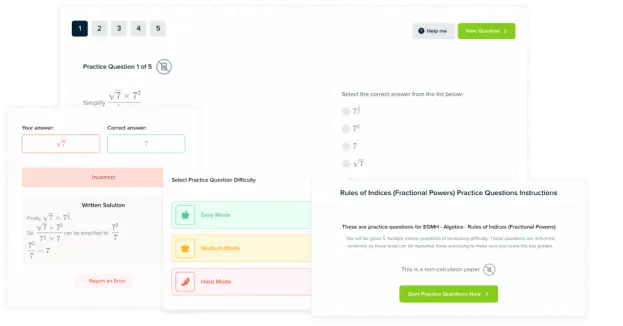Reverse Percentages
Reverse Percentages Revision
Reverse Percentages
Reverse percentages are where we are given a value or an amount that has increased or decreased by a certain percent, and then we have to use this information to calculate the original amount.
Make sure you are happy with the following topics before continuing.
Method 1: Reverse Percentages 1% to 100%
- Write the amount in the question as a percentage of the original value
- i.e. write an increase of 10\% as 110\% and a decrease of 10\% as 90\%
- Divide the amount by this value to find 1\% of the original value
- Multiply by 100
Example:
Felicity buys a dress in a sale. It is reduced by \textcolor{red}{40\%} down to a price of \textcolor{blue}{£54}. Work out the original price of the dress.
Step 1: We need to work out the cost of the dress as a percentage of its original value. We know it was \textcolor{red}{40\%} off so:
100\% - \textcolor{red}{40\%} = 60\%
Step 2: Divide the cost by 60\% to find 1\% of the original value
\begin{aligned} (\div \, 60) \, \, \, \, \, 60\% &= \textcolor{blue}{£54} \,\,\,\,\, (\div \, 60) \\ 1\% &= £0.90 \end{aligned}
Step 3: Multiply by 100 to get 100\% and the original value
\begin{aligned} (\times \, 100) \, \, \, \, \, 1\% &= £0.90 \,\,\,\,\, (\times \, 100) \\ 100\% &= \textcolor{purple}{£90} \end{aligned}
Method 2: Reverse Percentages using decimals
- Write the amount in the question as a percentage of the original value
- i.e. write an increase of 10\% as 110\% and a decrease of 10\% as 90\%
- Convert this percentage to a decimal or a fraction.
- Divide the amount by this value to find the original value
Example:
Felicity buys another dress in a sale. It is reduced by \textcolor{red}{30\%} down to a price of \textcolor{blue}{£42}. Work out the original price of the dress.
Step 1: We need to work out the cost of the dress as a percentage of its original value. We know it was \textcolor{red}{30\%} off so:
100\% - \textcolor{red}{30\%} = 70\%
Step 2: Convert this percentage to a decimal or fraction 70\% = 0.7
Step 3: Divide the sale value by this decimal equivalent to get the original value
£42 \div 0.7 = \textcolor{purple}{£60}
Example 1: Reverse Percentage
A TV cost \textcolor{limegreen}{£160} in a \textcolor{blue}{20\%} off sale. Calculate the original price of the TV before the sale.
[1 mark]
Step 1: 80\% = \textcolor{limegreen}{£160}
Step 2: Divide both sides by 80 to find 1\% = £2
Step 3: Multiply by 100 to find 100\%, i.e. the original amount: 100\% = \textcolor{purple}{£200}
Example 2: Reverse Percentage
A gym’s membership increased in price by \textcolor{red}{15\%} to \textcolor{orange}{£23} per month. What was the cost of the membership before the increase?
[1 mark]
Step 1: 115\% = \textcolor{orange}{£23}
Step 2: Divide both sides by 115 to find 1\% = £0.20
Step 3: Multiply by 100 to find 100\%, i.e. the original amount: 100\% = \textcolor{purple}{£20} per month
Example 3: Reverse Percentage
Rogelio’s new record for the 100m sprint is \textcolor{red}{10.8} seconds. This is \textcolor{limegreen}{5.8\%} faster than his previous record. What was his previous record (to 2 dp)?
[1 mark]
Step 1: 94.2 \% = \textcolor{red}{10.8} seconds
Step 2: Divide both sides by 94.2 to find 1\% = 0.11464
Step 3: Multiply by 100 to find 100\%, i.e. the original amount: 100\% = \textcolor{purple}{11.46} seconds (2 dp)
Reverse Percentages Example Questions
Question 1: The price of a t-shirt is reduced by 25\% to £13.50 during a sale. How much did it originally cost?
[1 mark]
To find the original price of the t-shirt we can divide the new cost by 0.75:
£13.50\div0.75=£18
Question 2: The price of a car has increased by 5% to £15,500. What was the cost of the car prior to this increase?
[1 mark]
To find the original cost of the car we can divide the new cost by 1.05:
£15,550\div1.05=£14,761.90
Question 3: A sports recovery bar contains 15.6 g of protein. 18\% of the recovery bar is protein. Work out the total mass of the bar.
[1 mark]
To find the total mass of the bar we can divide the mass of protein by 0.18:
15.6g \div \, 0.18 = 86.67g
Question 4: The crowd attendance at a recent football game is 46,235. This is 85\% capacity of the ground. What is the total capacity of the stadium?
[1 mark]
To find the total capacity of the stadium we can divide the recent attendance by 0.85:
46,235\div 0.85 =54,394
Question 5: The population of London is 9,300,000. This represents 14\% of the population of the United Kingdom. Work out the total population of the U.K.
[1 mark]
To find the total population of the U.K. we can divide the population of London by 0.14:
9,300,000\div 0.14 =66,428,571
Question 6: Petra buys a car. After 2 years of her owning it, it is now worth £10,120, which constitutes a 56\% decrease from its original value. What was its original value?
[2 marks]
If a car has decreased in value by 56\%, this means that the car is now worth 44\% of what it was worth before (100\% - 56\% = 44\%).
This means that the current value of £10,120 represents 44\% of the original price.
The original price is the 100\% amount, so we need to work out what 100\% represents if 44\% = £10,120. The easiest way to do this is to work out what 1\% is:
If
44\% = \pounds10,120
then
1\% = £10,120 \div 44 = \pounds230
If
1\% = \pounds230
then
100\% = £230 \times100 = \pounds23,000
So, the original price of Petra’s car was £23,000.
Another way we can view this question is by working what we would multiply the original amount by in order to work out the new value. If we are calculating a 56\% decrease, we would multiply the original amount by 0.44 to work out the new value. Therefore, if we know the new amount and wish to work out the original amount, then we can simply divide the new amount by 0.44:
\pounds10,120 \div 0.44 = \pounds23,000
Reverse Percentages Worksheet and Example Questions
(NEW) Reverse percentages Exam Style Questions
Level 4-5GCSENewOfficial MME
MME Premium Membership
£19.99
/monthLearn an entire GCSE course for maths, English and science on the most comprehensive online learning platform. With revision explainer videos & notes, practice questions, topic tests and full mock exams for each topic on every course, it’s easy to Learn and Revise with the MME Learning Portal.
Sign Up Now




